Floating glass chandeliers represent a remarkable fusion of artistry and functionality, transforming the way we perceive lighting in our living spaces. These fixtures, characterized by their ethereal appearance and intricate designs, create an illusion of lightness and elegance that can elevate any room, particularly kitchens. The use of glass in chandelier design is not merely for aesthetics; it also serves to diffuse light beautifully, casting a warm glow that enhances the ambiance of the space.
As kitchens evolve into multifunctional areas where cooking, dining, and socializing converge, the choice of lighting becomes increasingly significant. Floating glass chandeliers offer a unique solution that combines style with practicality, making them a popular choice among homeowners and designers alike. The allure of floating glass chandeliers lies in their ability to blend seamlessly with various design themes, from contemporary to rustic.
Their transparent nature allows them to complement a wide range of color palettes and materials, making them versatile additions to any kitchen. As we delve deeper into the world of floating glass chandeliers, we will explore their versatility, selection criteria, installation tips, and how they can be integrated with modern technology to enhance both functionality and aesthetics in your kitchen.
The Versatility of Floating Glass Chandeliers in Modern Kitchens
Floating glass chandeliers are not just decorative elements; they are transformative pieces that can redefine the character of a kitchen. Their versatility is evident in the myriad of styles available, ranging from minimalist designs featuring simple geometric shapes to more elaborate configurations that resemble cascading waterfalls of glass. This adaptability allows homeowners to select a chandelier that aligns with their personal taste and the overall theme of their kitchen.
For instance, a sleek, modern floating glass chandelier can serve as a striking focal point in a contemporary kitchen adorned with stainless steel appliances and quartz countertops, while a more ornate design can add a touch of vintage charm to a farmhouse-style kitchen. Moreover, floating glass chandeliers can be used in various configurations to suit different kitchen layouts. In open-concept spaces, these chandeliers can delineate areas, providing visual interest without obstructing sightlines.
For example, placing a large floating glass chandelier above an island can create a designated cooking and gathering space, while smaller fixtures can be used over dining tables or breakfast nooks to enhance intimacy. The ability to mix and match sizes and styles further amplifies their versatility, allowing homeowners to curate a lighting scheme that is both functional and aesthetically pleasing.
Choosing the Right Size and Style for Your Space
Selecting the appropriate size and style of a floating glass chandelier is crucial for achieving balance and harmony in your kitchen. A chandelier that is too large can overwhelm the space, while one that is too small may fail to make an impact. A common guideline for determining the right size is to add the dimensions of the room (in feet) together and convert that number into inches for the diameter of the chandelier.
For example, if your kitchen measures 12 feet by 15 feet, a chandelier with a diameter of approximately 27 inches would be ideal. This rule provides a starting point, but personal preference and specific design elements should also be considered. In terms of style, it is essential to consider the existing decor and architectural features of your kitchen.
A modern kitchen with clean lines may benefit from a sleek, minimalist floating glass chandelier that emphasizes simplicity and elegance. Conversely, a traditional kitchen might call for a more ornate design with intricate detailing and vintage finishes. Additionally, consider the color scheme of your kitchen; clear glass fixtures can enhance lightness and openness, while tinted or frosted glass can introduce warmth and depth.
Ultimately, the chosen chandelier should not only illuminate the space effectively but also resonate with your personal style and enhance the overall aesthetic.
Installation and Maintenance Tips for Floating Glass Chandeliers
Installing a floating glass chandelier requires careful planning and execution to ensure safety and optimal performance. Before installation, it is essential to assess the electrical wiring in your kitchen. If you are not experienced with electrical work, hiring a licensed electrician is advisable to avoid potential hazards.
The chandelier Nounhouse should be hung at an appropriate height—generally 30 to 36 inches above countertops or tables—to provide adequate illumination without obstructing views or movement. Additionally, consider using adjustable mounting hardware if you anticipate needing to change the height in the future. Maintenance of floating glass chandeliers is relatively straightforward but requires regular attention to keep them looking their best.
Dust accumulation can dull the brilliance of glass fixtures, so routine cleaning is essential. Use a soft microfiber cloth or a feather duster to gently remove dust from the surface. For deeper cleaning, a mixture of warm water and mild dish soap can be used; however, avoid abrasive cleaners that could scratch the glass.
If your chandelier features intricate designs or multiple glass components, take care to clean each piece individually to maintain its clarity and shine. Regular maintenance not only preserves the aesthetic appeal but also ensures that the fixture continues to function effectively over time.
Incorporating LED Lighting and Smart Technology
The integration of LED lighting into floating glass chandeliers has revolutionized how we approach kitchen illumination. LED bulbs are energy-efficient, long-lasting, and available in various color temperatures, allowing homeowners to customize their lighting experience according to their preferences. When selecting LED bulbs for your chandelier, consider options that mimic natural daylight for tasks like cooking or softer hues for creating a cozy atmosphere during meals.
Additionally, many LED bulbs are now dimmable, providing further flexibility in adjusting brightness levels based on the time of day or occasion. Smart technology has also made its way into chandelier design, offering homeowners unprecedented control over their lighting systems. Smart chandeliers can be connected to home automation systems, allowing users to adjust brightness levels or color temperatures via smartphone apps or voice commands through virtual assistants like Amazon Alexa or Google Assistant.
This level of control enhances convenience and can contribute to energy savings by allowing users to turn off lights remotely or set schedules for when lights should be on or off. Incorporating smart technology into your floating glass chandelier not only modernizes your kitchen but also adds an element of sophistication that aligns with contemporary living.
Enhancing Your Kitchen’s Aesthetic with Floating Glass Chandeliers
Floating glass chandeliers have an innate ability to enhance the aesthetic appeal of kitchens by serving as statement pieces that draw attention and admiration. Their unique designs can complement various architectural styles—from sleek modernism to rustic charm—making them suitable for diverse settings. For instance, in a minimalist kitchen characterized by clean lines and neutral colors, a geometric floating glass chandelier can serve as an eye-catching focal point that adds depth without overwhelming the space.
Conversely, in a more eclectic kitchen filled with vibrant colors and textures, an ornate chandelier with multiple glass elements can harmonize with the overall decor while providing functional lighting. The placement of floating glass chandeliers also plays a significant role in enhancing your kitchen’s aesthetic. Strategically positioning these fixtures above key areas such as islands or dining tables not only provides necessary illumination but also creates visual interest at different heights within the room.
Layering lighting sources—such as combining pendant lights with floating chandeliers—can further enrich the ambiance by creating depth and dimension. By thoughtfully considering both design elements and placement strategies, homeowners can leverage floating glass chandeliers to create inviting spaces that reflect their personal style while remaining functional.
Budget-Friendly Alternatives and DIY Options
While floating glass chandeliers can be luxurious additions to any kitchen, there are budget-friendly alternatives that can achieve similar effects without breaking the bank. One option is to explore pendant lights made from materials like acrylic or resin that mimic the look of glass but are often more affordable. These fixtures can provide a similar aesthetic while being lightweight and easier to install.
Additionally, many home improvement stores offer ready-made lighting solutions that incorporate glass elements at lower price points. For those inclined towards creativity and hands-on projects, DIY options abound for crafting unique floating glass chandeliers tailored to individual tastes. Using materials such as mason jars or repurposed glass bottles can yield stunning results when combined with simple wiring kits available at craft stores.
By experimenting with different shapes and arrangements, homeowners can create one-of-a-kind fixtures that reflect their personality while adding character to their kitchens. Online tutorials provide step-by-step guidance for those new to DIY projects, making it accessible for anyone interested in enhancing their space on a budget.
Elevating Your Kitchen with a Floating Glass Chandelier
Floating glass chandeliers stand out as exceptional lighting solutions that combine elegance with functionality in modern kitchens. Their versatility allows them to adapt seamlessly to various design styles while providing essential illumination for cooking and dining areas. By carefully selecting the right size and style for your space, you can create an inviting atmosphere that reflects your personal taste.
Incorporating LED technology and smart features further enhances their appeal by offering energy efficiency and convenience in managing your lighting environment. With proper installation and maintenance practices, these stunning fixtures can remain beautiful focal points for years to come. Whether you opt for high-end designs or budget-friendly alternatives through DIY projects, floating glass chandeliers have the potential to elevate your kitchen’s aesthetic significantly, making them worthwhile investments for any homeowner looking to enhance their living space.


